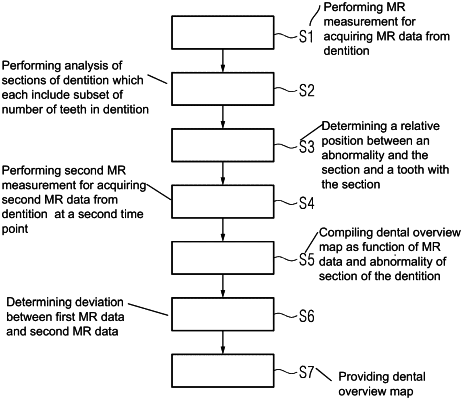| CPC G06T 7/0012 (2013.01) [A61B 5/055 (2013.01); A61B 5/4547 (2013.01); A61B 5/4842 (2013.01); A61B 2576/00 (2013.01); G06T 2207/10088 (2013.01); G06T 2207/30036 (2013.01)] | 12 Claims |

|
1. A method for compiling a dental overview map of a dentition of an examination object on the basis of magnetic resonance (MR) data from a magnetic resonance measurement of the dentition, comprising:
performing an MR measurement for acquiring MR data from the dentition, wherein an imaging volume of the MR measurement is matched with a volume of the dentition, and the imaging volume includes a number of teeth in the dentition; and
performing an analysis of sections of the dentition, each of which includes a subset of the number of teeth in the dentition in order to determine an abnormality on the basis of the MR data, wherein an abnormality is determined in at least one section,
wherein the MR measurement is a first MR measurement, the first MR measurement for acquiring first MR data from the dentition is performed at a first time point, a first imaging volume of the first MR measurement is matched with a first volume of the dentition and includes a first number of teeth, and the at least one section in which the abnormality is determined is a first section,
wherein in one step, a second MR measurement for acquiring second MR data from the dentition is performed at a second time point, wherein a second imaging volume of the second MR measurement with a second volume of the dentition and includes at least one tooth and wherein at least one imaging parameter of the second MR measurement is determined as a function of the abnormality of the first section, and
wherein the performance of the second MR measurement for acquiring second MR data from the second section takes place with a third recording quality, and the third recording quality is lower than a first recording quality used during the performance of the first MR measurement for the acquisition of the first MR data from the first section.
|